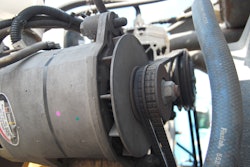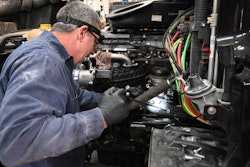Parts of the country have already had plenty of snow, and sub-freezing temperatures aren’t far away elsewhere. That means new stresses on your truck, many of which could sideline your operation if you don’t take time to prepare.
Following are winterizing tips are based on interviews with Joe Puff, a vice president with NationaLease; Brent Bergevin, vice president of transportation for Love’s; Rich Nagel, a marketing director for Bendix; Homer Hogg, director of technical service for TravelCenters of America; Jon Salter, director of shop operations with Pilot Flying J Truck Care; Sean Storey, a vice president with Corcentric; Tom Herrick, a general manager with Transervice Logistics; and Transervice vice presidents Gino Fontana and Mark Finger.
Air system and brakes
When too much moisture gets into the truck’s air system, it creates problems, and more so when the moisture freezes, which can lock up valves and brakes. Drain air tanks routinely to keep moisture out of the air valves. The dryer’s purge valve, which is key to removing moisture, can easily be contaminated in the winter because of water, chemical treatment, salt and sand on many roads.
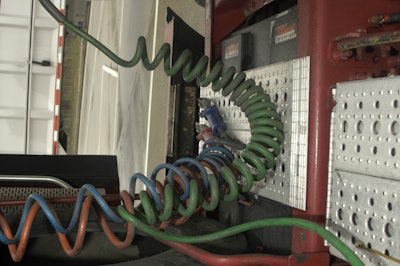 “Drain the moisture from air tanks routinely to prevent moisture from entering air valves,” said Joe Puff, a vice president with NationaLease. Excessive moisture “may be an indication of an air dryer malfunction, bad filter or excessive air leaks.”
“Drain the moisture from air tanks routinely to prevent moisture from entering air valves,” said Joe Puff, a vice president with NationaLease. Excessive moisture “may be an indication of an air dryer malfunction, bad filter or excessive air leaks.”The cartridge filter should be changed as often as recommended by the manufacturer or when there are signs of excessive moisture.

Keep moving parts, such as all S-cams, slack adjusters and other moving parts well lubricated. When old grease gets thick enough to slow the release of brakes, it can cause them to overheat.
Battery and electrical
Since more battery power is required to crank an engine in cold weather, it’s good to test batteries before severe weather arrives. A discharged battery can freeze at around 30 degrees. Lower temps are required before a fully charged one begins to freeze.
A simple smart battery tester or carbon pile load tester can tell a lot about a battery’s health.
Wiring with cuts and nicks can also sabotage an electrical system. Check wiring connections to ensure they’re tight and clean. Coat them with dielectric grease or spray to prevent corrosion.
Belts
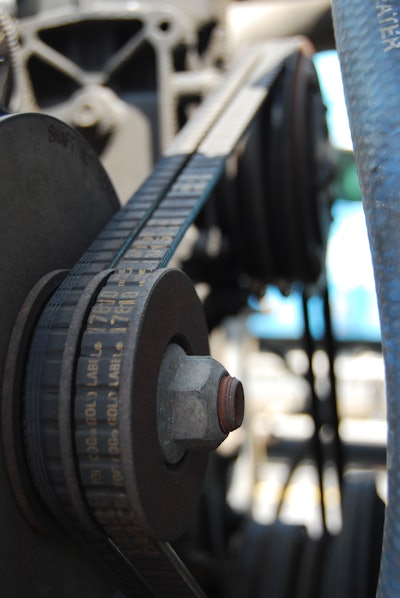 “It is very difficult, if not impossible, to visually detect a bad belt,” said Homer Hogg, director of technical service for TravelCenters of America. (photo by Todd Dills)
“It is very difficult, if not impossible, to visually detect a bad belt,” said Homer Hogg, director of technical service for TravelCenters of America. (photo by Todd Dills)Frozen belts can snap if they’re in poor condition. Because of the components in modern belts, the newer belts don’t show visible signs of wear, so a gauge must be used to detect the belt’s true condition.
It’s also recommended to check belt tensioners and pulleys. In most cases, replace the tensioner during every other belt replacement. It’s also good to check belt alignment. When it’s off, it sometimes produces a chirping sound.
Coolant
If you travel into areas of severe low temps, be sure your coolant freeze point is low enough to protect your truck.
Coolant’s freeze protection level testing can be done with a refractometer, test strips or a hydrometer, though a floating ball-type hydrometer can get contaminated over time and provide inaccurate results.
A pressure test of the entire coolant system can help detect potential leak points, such as poor connections and weak components. Check cracking or chafing hoses, coolant leaking around clamps, debris in the radiator, and overall condition of belts, fan and hub.
Not all coolants are compatible with each other, so heed product warnings before topping off with a different coolant. In a worst case, mixed coolants can deplete the inhibitors, possibly harming the engine and leading to failure.
Windshield
Typical windshield washer fluid resists icing down to about 20 degrees. For colder climates, use a fluid that’s more of a deicer. Some products are good down to -20 degrees.
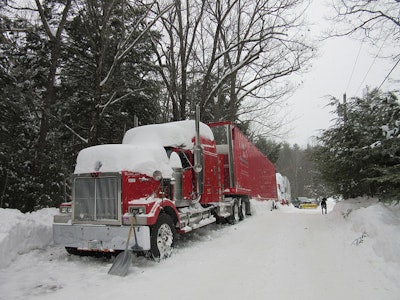 “Don’t waste time waiting for your windshield to defrost,” said Jon Salter, of Pilot Flying J Truck Care. “By adding anti-frost and anti-fog treatments, you can hit the road and be on your way.” (photo by Chris Harkins)
“Don’t waste time waiting for your windshield to defrost,” said Jon Salter, of Pilot Flying J Truck Care. “By adding anti-frost and anti-fog treatments, you can hit the road and be on your way.” (photo by Chris Harkins)To avoid excessive time defrosting your windshield, consider using anti-frost and anti-fog treatments, a windshield washer fluid heater or heated wiper blades.
It’s important to ensure the HVAC system is working properly to ensure sufficient defrost capability for the windshield. That includes being sure the system’s duct doors move properly.
Fuel system
The fuel/water separator should be checked daily because the temperature difference between the ambient temperature and the fuel in the tanks can cause condensation. When too much moisture is suspended in diesel fuel, it can severely damage injectors and fuel pumps.
As for prevention of gelling in freezing temps, check this recent Q&A on winter fuel additives.
Tires
Because cold weather can noticeably lower tire pressure, frequent checks, especially when your operation moves to an area of much lower temps, are recommended.
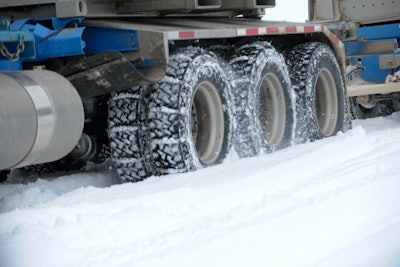 “As the weather cools, a 10-degree drop in the air temperature will decrease each tire’s pressure by approximately 1 pound per square inch,” said Sean Storey, a vice president with Corcentric.
“As the weather cools, a 10-degree drop in the air temperature will decrease each tire’s pressure by approximately 1 pound per square inch,” said Sean Storey, a vice president with Corcentric.Tire life can be extended by making frequent inspections, maintaining proper inflation, checking valve stem caps, washing the tires and wheels, and rotating and balancing the tires on a routine basis.
Also check tire chains to ensure they’re ready to last another season.
Emergency items
In the event of a breakdown during severe weather, it helps to be prepared with certain items, such as a first aid kit, a blanket, road flares, a fire extinguisher and a current road atlas.
He also suggested having onboard packaged food, extra water, extra-warm clothes, weatherproof boots/clothes, a knit cap, a flashlight and extra batteries, an emergency cell phone battery and extra prescription medicine.





